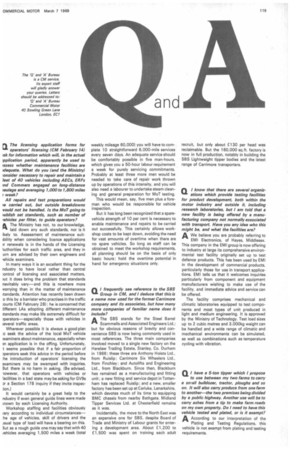ri The licensing application forms for
Page 121

If you've noticed an error in this article please click here to report it so we can fix it.
operators' licensing (CM February 14) sk for information which will, in the actual ipplication period, apparently be used to rssess whether maintenance facilities are !dequate. What do you land the Ministry) 121rsider necessary to repair and maintain a feet of 40 vehicles including A£Cs, ER Fs nd Commers engaged on long-distance raulage and averaging 1,000 to 1.800 miles r week?
All repairs and test preparations would Is carried out, but outside breakdowns you'd not be handled. Is the MoT going to oublish set standards, such as number of 'Orioles per fitter, to guide operators?
& The Ministry has not, to our knowledge, laid down any such standards, nor is it Ikely to. Assessment of maintenance suitibility when considering licence applications ir renewals is in the hands of the Licensing kuthorities for each traffic area, and they in urn are advised by their own engineers and 'allele examiners.
In many ways it is an excellent thing for the ndustry to have local rather than central :ontrol of licensing and associated matters, )ut it does bring the problem that standards nevitably vary—and this is nowhere more vorrying than in the matter of maintenance ;tandards. Attention has recently been drawn o this by a barrister who practises in the traffic ourts ICIVI February 28); he is concerned that lifferent LAs adopting different maintenance :tandards may make life extremely difficult for )perators—especially those with vehicles in ;everal traffic areas.
Wherever possible it is always a good plan
o seek the advice of the local MoT vehicle axaminers about maintenance, especially when an application is in the offing. Unfortunately, t seems possible that if a fair proportion of )perators seek this advice in the period before :he introduction of operators' licensing the examiners may be swamped with inquiries. 3ut there is no harm in asking. (Be advised, lowever, that operators with vehicles or `acilities in a bad state may be asking for GV9s 3r a Section 178 inquiry if they invite inspec:ion.)
It would certainly be a great help to the ndustry if even general guide lines were made ;nown by each Licensing Authority.
Workshop staffing and facilities obviously eery according to individual circumstances— :he age of vehicles, skill of drivers and the sual type of load will have a bearing on this. 3ut as a rough guide one may say that with 40 .fehicles averaging 1,500 miles a week (total weekly mileage 60,000) you will have to complete 10 straightforward 6,000-mile services every seven days. An adequate service should be comfortably possible in five man-hours, which gives you a 50-hour labour requirement a week for purely servicing commitments. Probably at least three more men would be needed to take care of repair work thrown up by operations of this intensity, and you will also need a labourer to undertake steam cleaning and general preparation for MoT testing.
This would mean, say, five men plus a foreman who would be responsible for vehicle in But it has long been recognized that a sparevehicle strength of 10 per cent is necessary to enable maintenance and repairs to be carried Out successfully. This certainly allows workshop costs to be kept down, avoiding the need for vast amounts of overtime when there are no spare vehicles. So long as staff can be obtained to meet the workshop requirements, all planning should be on the basis of only basic hours; hold the overtime potential in hand for emergency situations only.












































































































































































